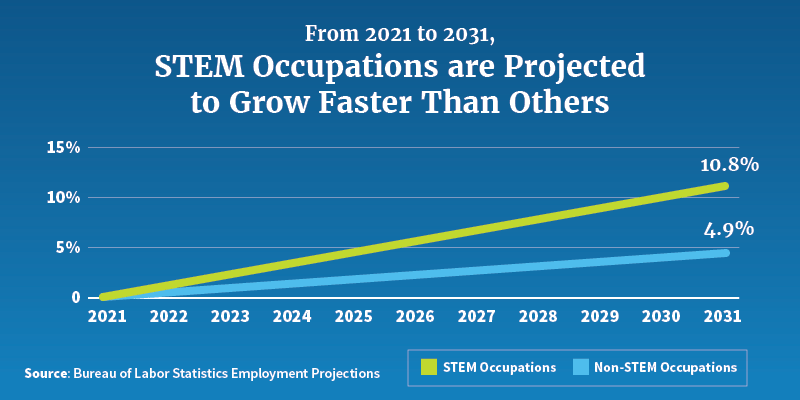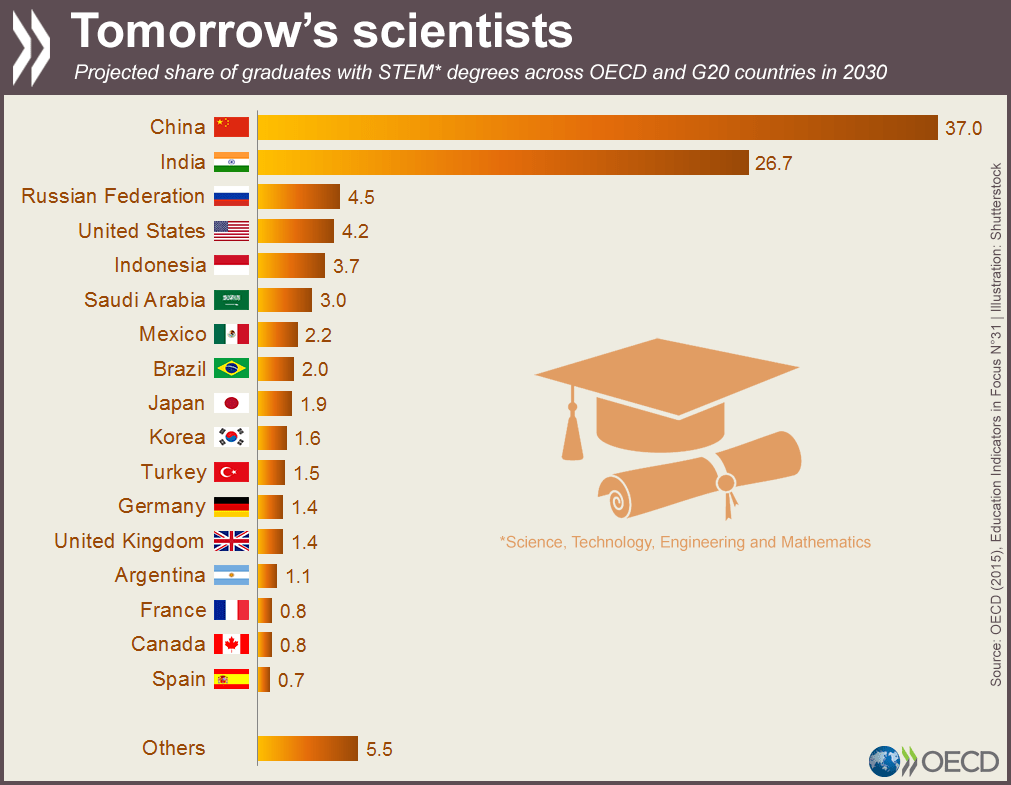The STEM skills gap: a growing challenge for countries to overcome
Table of contents
The looming STEM gap — How a shortage of skilled workers threatens the future of strong nations
STEM (Science, Technology, Engineering, and Mathematics) fields have emerged as key drivers of economic growth and innovation worldwide. Governments and private organizations are investing substantially in STEM education and research to maintain competitiveness in the global economy.
A National Science Foundation report highlights that STEM industries in the United States generated a staggering $2.3 trillion in revenue in 2015, equivalent to 17% of the country’s total GDP. Moreover, the report reveals that STEM-related jobs had a median annual wage almost twice that of non-STEM jobs. The graph below suggests that STEM fields will continue to play a crucial role in boosting economic growth and generating employment opportunities.
Source: BLS
At the same time, the shortage of skilled workers in STEM fields is becoming an increasingly pressing issue for many countries worldwide. This shortage is a challenge for companies seeking to fill critical positions and poses a significant threat to a country’s future economic growth and competitiveness. Many countries are facing a shortage of STEM skills, including:
The United States. The US has been experiencing a shortage of STEM workers in various sectors, including healthcare, information technology, and engineering. According to a National Association of Manufacturing and Deloitte report, the US will have a shortage of up to 3.5 million STEM workers by 2025.
The United Kingdom. The UK has been experiencing a shortage of STEM workers, particularly in the engineering and technology sectors. A report by the Royal Academy of Engineering predicts that the UK would need to produce 1.8 million more engineers and technicians by 2025 to meet demand.
Germany. According to a 2022 report by the German Economic Institute (IW) in Cologne, in April 2022, Germany was short around 320,000 STEM specialists.
Japan. Japan has been facing a shortage of STEM workers in various sectors, including information technology, engineering, and healthcare. The Ministry of Economy, Trade, and Industry projects a shortfall of 450,000 information technology professionals in Japan by 2030, likening the situation to a digital cliff looming before the world’s third-largest economy.
Despite efforts to increase STEM education, the problem is complex and requires a global solution. The shortage of STEM professionals threatens scientific advances needed to address pressing global issues and stifles economic growth. It is a paradox that must be addressed to secure the future of our countries.
Four reasons for the shortage of skilled STEM workers
As technology continues to play an increasingly important role in driving economic growth and innovation, the shortage of skilled workers in STEM fields has become a critical challenge for many industries and economies. Despite efforts to encourage more young people to pursue careers in these fields, the number of available skilled workers has failed to keep up with demand, leading to a shortage of qualified professionals in many areas. Let’s explore some of the key reasons for the shortage of skilled workers in STEM fields and how they contribute to this pressing issue.
Shortage of STEM workers with soft skills
Over-reliance on rote learning and memorization in STEM subjects often leads graduates to find it challenging to apply the concepts they’ve studied to real-world problems in their workplaces. This is a problem in countries such as India, where employers struggle to fill engineering positions due to graduates’ consistent lack of critical thinking and interpersonal skills.
Soft skills relate to how one works — teamwork, leadership, emotional intelligence (communication and conflict management), maintaining a growth mindset, and showing initiative. In the white paper “The Global STEM Paradox,” the New York Academy of Sciences explains: “Especially in a job market that’s becoming increasingly saturated with degree-holding individuals, having or not having soft skills could be a deciding factor among suitable candidates. The competitive market will force graduates to look beyond their technical skills gained from college and adapt to competition that wants more than just the hard calculations.”
It is becoming increasingly difficult for employers to find STEM candidates who have the necessary technical skills and possess the essential soft skills. These soft skills are essential in demonstrating to employers that the candidate has the potential to succeed and can effectively apply their technical knowledge in the workplace.
An unbalanced global talent pool
The education system in most countries is insufficiently aligned with industry to develop student skills and aspirations that meet employer needs. Look at the projected percentage of the G20 workforce with a STEM qualification by 2030:
Source: OECD
Countries with a smaller pool of STEM talent must compete with others to attract and retain the limited supply of qualified workers. As a result, these countries may struggle to fill critical STEM positions, leading to skills shortages that can have significant economic and social consequences. Furthermore, the global STEM talent pool imbalance can create a situation where countries with a surplus of STEM talent struggle to find employment opportunities while others face a shortage of skilled workers. Addressing the global talent pool imbalance will ensure a sufficient supply of skilled workers in STEM fields to support economic growth and innovation worldwide.
Loss of highly skilled workers
Companies may be losing highly skilled STEM workers for a variety of reasons. One reason is the intense competition for top talent in these fields. With a shortage of qualified professionals in many areas, companies may struggle to attract and retain the most talented individuals, leading to turnover and talent loss.
Factors such as inadequate compensation, lack of career growth opportunities, and poor work–life balance can also contribute to the loss of high-skilled STEM workers. These professionals are often in high demand and may receive competing job offers with better compensation or opportunities for growth. Companies that fail to offer competitive compensation or meaningful career growth opportunities may struggle to retain professionals.
Untapped talent pools
Another factor that may contribute to the loss of high-skilled STEM workers is the lack of diversity and inclusivity in many STEM workplaces. Women, rural populations, minority ethnic groups, people from lower socio-economic classes, and other marginalized groups are acutely underrepresented in STEM fields in most developed and developing countries. For example, according to the STEM women report, “Overall, the percentage of female graduates with core STEM degrees is steadily growing. However, the split is still just 26%.”
This lack of participation of underrepresented or disadvantaged groups in STEM fields not only limits gender and income equality but also impedes innovation and economic advancement, as large swaths of talent are underutilized. Together, these challenges create a self-reinforcing global cycle that is difficult to break.
Solutions that companies can take to close the STEM skills gap (with examples)
The shortage of skilled workers in STEM fields has become a significant challenge for companies worldwide. However, HRForecast recommends several steps companies can take to close the STEM skills gap and attract and retain skilled workers. Here are some strategies that companies can use:
Location analysis
Location analysis can be crucial in addressing the STEM skills gap. Companies can strategically establish or expand their operations in regions with a surplus of skilled workers or untapped talent.
For example, a technology company may establish a new office or research and development center in a city or region with a high concentration of tech talent. By doing so, they can tap into a pool of skilled workers and attract top talent to their organization. Additionally, by expanding into new regions, companies can help spur economic growth and create job opportunities for individuals with STEM skills.
Furthermore, location can be leveraged to address diversity and inclusion within the STEM workforce. By establishing operations in regions with diverse populations, companies can tap into a wider range of perspectives and experiences, creating a more inclusive and innovative workplace.
Check out how HRForecast supported our client, IAV, in making a well-informed decision regarding a new location by providing valuable data-driven insights.
Develop a talent pipeline
Developing a talent pipeline is another effective solution for closing the STEM skills gap. It involves identifying individuals who have the potential to succeed in STEM careers and providing them with the necessary support and training to develop the required skills.
For example, a company in the biotech industry could develop a talent pipeline by partnering with local universities to identify promising students in relevant fields such as biology, chemistry, or engineering. The company could offer these students internships, apprenticeships, or other training opportunities, providing them with hands-on experience and industry exposure.
Additionally, the company could establish a mentorship program where experienced professionals guide and support these students as they develop their skills and prepare for careers in STEM. This approach can help ensure that the company has a steady supply of skilled talent for the future, addressing the STEM skills gap sustainably.
Upskill existing employees
Companies can upskill their existing employees by providing training and development opportunities that help them acquire new skills and knowledge. This can include offering online courses, workshops, and other learning opportunities tailored to the organization’s specific needs.
Let’s take the example of a technology company experiencing a shortage of software engineers. This company could address the skills gap by upskilling its current employees through a training program designed to help employees learn coding languages such as Python, Java, or JavaScript and provide them with the skills needed to develop software applications.
By providing this training to current employees, the company can address the skills gap in software engineering and overcome the shortage of software engineers. Additionally, upskilling current employees can help retain existing talent within the company, reducing the costs associated with employee turnover and recruitment.
Upskill your workforce in alignment with future-oriented job requirements and business goals
Our smartPeople solution provides personalized recommendations of career paths for your employees by detecting and understanding the future skills relevant to your industry
Use data-driven insights
Using data-driven insights can help companies close the STEM skills gap by identifying areas of high demand for certain skills and predicting future workforce needs. By analyzing data related to job postings, applicant qualifications, and internal workforce metrics, companies can gain valuable insights into current and future workforce trends.
For example, a pharmaceutical company may use data analysis to identify a growing demand for data scientists with a background in biology or chemistry. By recognizing this trend early on, the company can invest in upskilling or reskilling existing employees to meet this demand or begin recruiting new talent with these backgrounds.
Data analysis can also help companies identify potential skills gaps within their existing workforce so they can address them through targeted training or recruitment efforts. For instance, a tech company may identify a gap in the programming skills of their existing software engineers. They can then provide training or mentorship programs to upskill these employees and help them stay relevant in a rapidly changing industry.
Moreover, data-driven insights can help promote diversity and inclusion within the STEM workforce. By analyzing data related to job postings, applicant qualifications, and internal workforce metrics, companies can identify areas where underrepresented groups are disproportionately excluded. This information can help inform targeted recruitment efforts and diversity initiatives to create a more inclusive and representative STEM workforce.
Read more on how HRForecast’s market intelligence solution and data-driven insights can help close the skills gap in STEM fields by providing HR leaders with a comprehensive understanding of current and future talent market trends and identifying potential talent pools that may be overlooked.
STEMming the talent shortage: Questions HR leaders must answer
According to a report by the World Economic Forum, there is estimated to be a global shortage of over 85 million skilled workers by 2030, with the largest gap in technology and engineering. This shortage could result in a potential loss of $8.5 trillion in global GDP over the next decade.
On the other hand, companies that invest in filling the skills gap in the STEM field are seeing significant returns. A study by Accenture states that “for every dollar Accenture invests in learning, the company receives that dollar back plus an additional $3.53 in measurable value to its bottom line—in other words, a 353 percent return on learning.”
The shortage of skilled workers in the STEM field is a global challenge that requires companies’ immediate attention to upskilling their current employees, developing a talent pipeline, leveraging data-driven insights, and strategically locating their well-positioned operations to succeed in the future.
As HR leaders, it’s crucial to ask yourselves whether you have started working on closing the STEM skills gap in your organization. Are you investing in the development of your current employees? Are you developing a talent pipeline? Are you using data-driven insights to make informed talent acquisition and retention decisions? These are critical questions that require urgent attention to ensure the future success of our companies and the global economy.
Take the quiz to find out if you are a future-ready HR leader!
Stay up to date with our newsletter
Every month, we’ll send you a curated newsletter with our updates and the latest industry news.





























 info@hrforecast.de
info@hrforecast.de
 +49 89 215384810
+49 89 215384810






